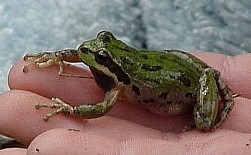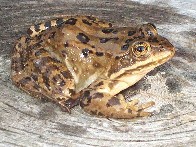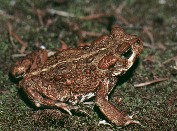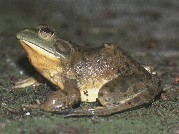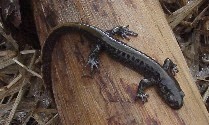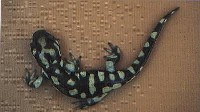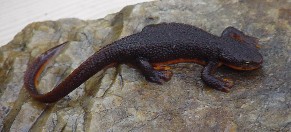-
Order Anura -- Frogs and Toads
- Pacific chorus frog (Pseudacris regilla) -- native
- Columbia spotted frog (Rana luteiventris) -- native
- Western toad (Bufo boreas) -- native
- Bullfrog (Rana catesbeiana) -- introduced
-
Order Urodela -- Salamanders and Newts
- Long-toed salamander (Ambystoma macrodactylum columbiana) -- native
- Tiger salamander (Ambystoma tigrinum) -- native
- Rough-skinned newt (Taricha granulosa) -- likely introduced
Anura -- frogs & toads
Pacific chorus frog (Pseudacris regilla) or Pacific treefrog (Hyla regilla) -- native The Pacific treefrog is widespread throughout the Pacific northwest, and has not been shown to be in decline. This is the frog that one hears calling at night on the Palouse in the Spring. Status: Unprotected nongame species
Global Rank: G5
State Rank: S5
<http://www.sd281.k12.id.us/pamp/pampnew/idtree.htm>
<http://imnh.isu.edu/digitalatlas/bio/amph/anurans/psre/psrefra.htm>
Columbia spotted frog (Rana luteiventris) -- native The Columbia spotted frog is listed as a Species of Special Concern by the Idaho Department of Fish and Game. The closely related Rana pretiosa has declined west of the Cascade Mountains. Status: Unprotected nongame species
Global Rank: G4
State Rank: S4
<http://www.sd281.k12.id.us/pamp/pampnew/idspotted.htm>
<http://imnh.isu.edu/digitalatlas/bio/amph/anurans/ralu/ralufra.htm>
Western toad (Bufo boreas) -- native The Western toad is listed as a Species of Special Concern by the Idaho Department of Fish and Game. It has declined in Colorado; however, little is known about its status in northern Idaho. Status: Protected nongame species
Global Rank: G4
State Rank: S4
<http://www.sd281.k12.id.us/pamp/pampnew/idtoad.htm>
<http://imnh.isu.edu/digitalatlas/bio/amph/anurans/bubo/bubofra.htm>
Bullfrog (Rana catesbeiana) -- introduced to Idaho The bullfrog is our only non-native anuran, the result of introductions form the Eastern United States as early as the 1930’s. It preys upon and out-competes native amphibians, and is believed to be displacing amphibians throughout the Northwest. The bullfrog requires permanent ponds -- its tadpoles require two or more seasons to mature -- and so it is benefitting from the artificial ponds created on the Palouse. Ephemeral wetlands are important and may be the hold-out for our native amphibians, because introduced bullfrogs cannot breed there.
Status: Game species
Global Rank: G5
State Rank: SE nonnative species to Idaho
<http://www.sd281.k12.id.us/pamp/pampnew/idbull.htm>
<http://imnh.isu.edu/digitalatlas/bio/amph/anurans/raca/racafra.htm>
Urodela -- salamanders & newts
Long-toed salamander (Ambystoma macrodactylum columbiana) -- native The long-toed salamander is our most common urodele species; it appears to be abundant. These are the first amphibians to be apparent in the spring. They begin breeding as soon as the ice begins to melt along pond edges, as early as January 31.
Status: Unprotected nongame species
Global Rank: G5
State Rank: S5
<http://www.sd281.k12.id.us/pamp/pampnew/idsal.htm>
<http://imnh.isu.edu/digitalatlas/bio/amph/urodela/amma/ammafra.htm>
Tiger salamander (Ambystoma tigrinum) -- native The tiger salamander probably is the most elusive amphibian on the Palouse -- some researchers have found only dead specimens.
Status: Unprotected nongame species
Global Rank: G5
State Rank: S5
<http://www.sd281.k12.id.us/pamp/pampnew/idtiger.htm>
<http://imnh.isu.edu/digitalatlas/bio/amph/urodela/amti/amtifram.htm>
Rough-skinned newt (Taricha granulosa) -- possibly introduced to Palouse Roughskin newts are found in only a few ponds on the Palouse. They are quite toxic, and may have displaced other amphibians in the Pacific northwest. It is suspected that roughskin newts in the Rocky Mountains and the Palouse bioregion are the result of introduction from west of the Cascades. Comparison of DNA from local and western newts should be made to determine their origin. Status: Unprotected nongame species
Global Rank: G3
State Rank: S? non-native species
<http://www.sd281.k12.id.us/pamp/pampnew/idnewt.htm>
<http://imnh.isu.edu/digitalatlas/bio/amph/urodela/tagr/tagrfram.htm>
All photos (c) Lee Anne Eareckson or Eva Strand.
References:
Based on "Monitoring Amphibians on the Palouse" presentation by Lee Anne Eareckson
and website at <http://www.sd281.k12.id.us/pamp/pampnew/>
AMPHIBIAN PREFERENCES AND POPULATION DYNAMICS IN THE PALOUSE REGION OF NORHTERN IDAHO A Thesis Presented in Partial Fulfillment of the Requirements for the Master of Science with a Major in Fish and Wildlife Resources in the College of Graduate Studies University of Idaho by Ryan Monello March 1998
Data on these amphibian distributions were available in The Masters Thesis of Ryan Monello, a University of Idaho graduate student who surveyed 37 ponds in the Palouse in 1996-97.
Links (which open in a new window) are to the
Digital Atlas of Idaho project, on the
Idaho Museum of Natural History web server, housed at
Idaho State University.
Digital Atlas of Idaho Idaho Amphibian checklist <http://imnh.isu.edu/digitalatlas/bio/amph/main/amphcklt.htm>
